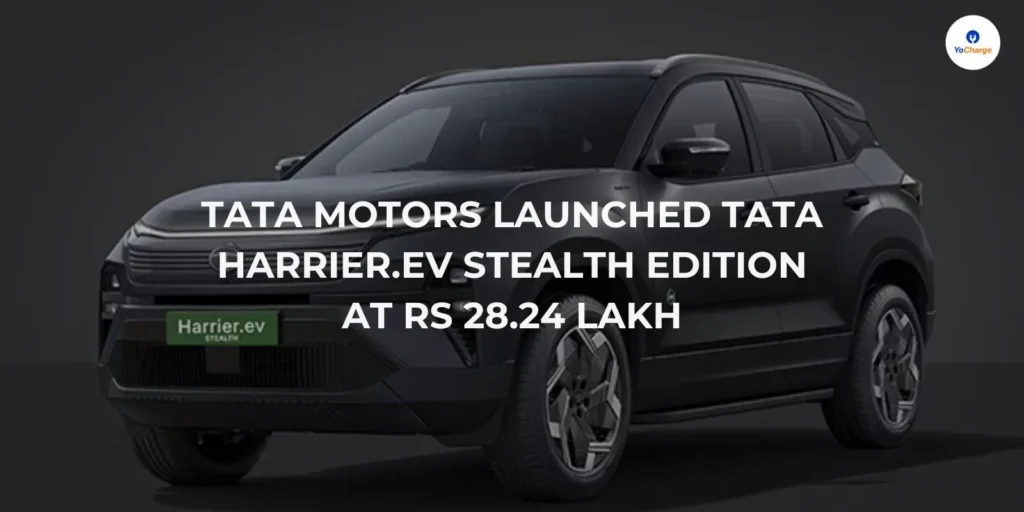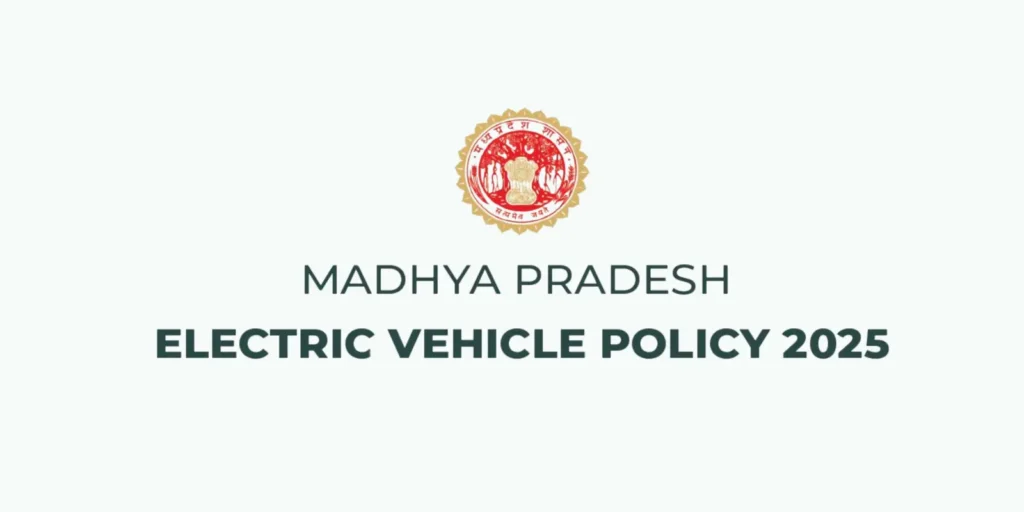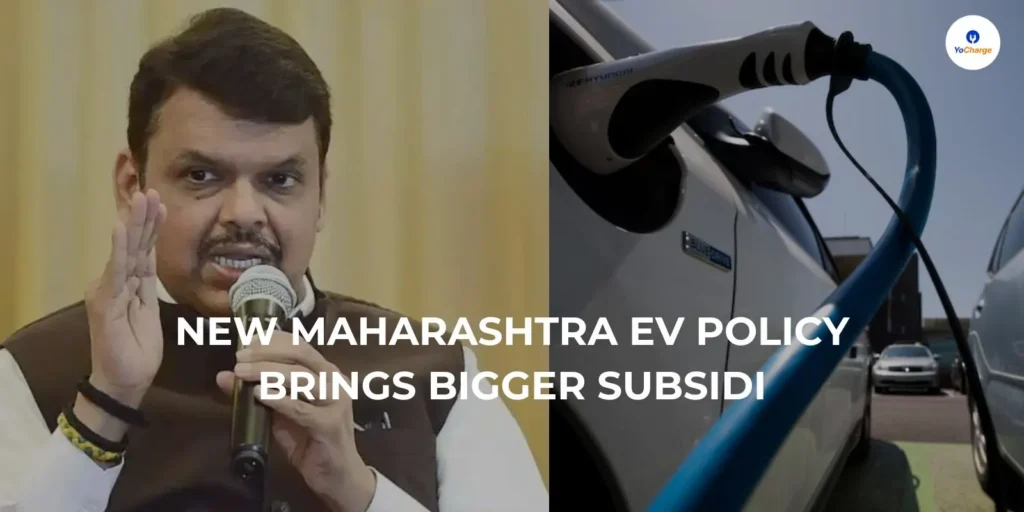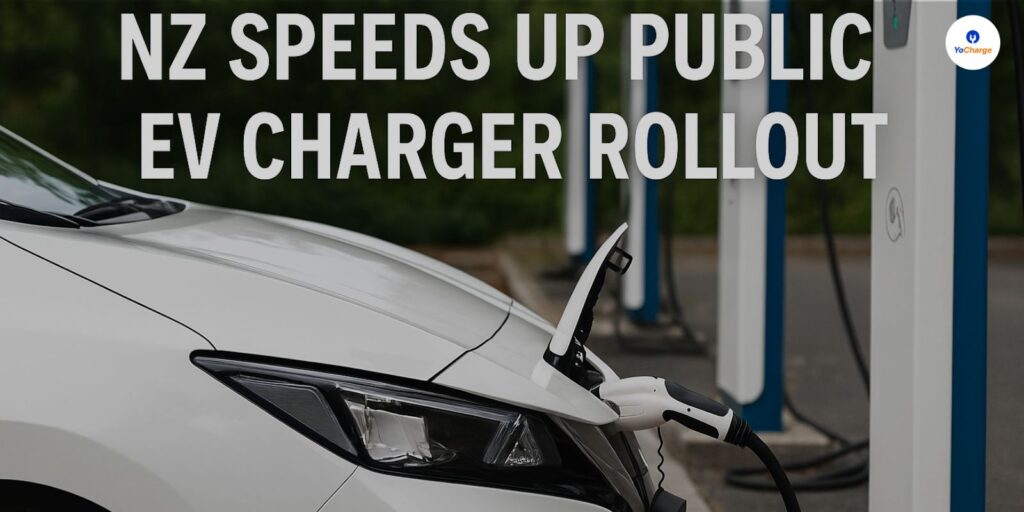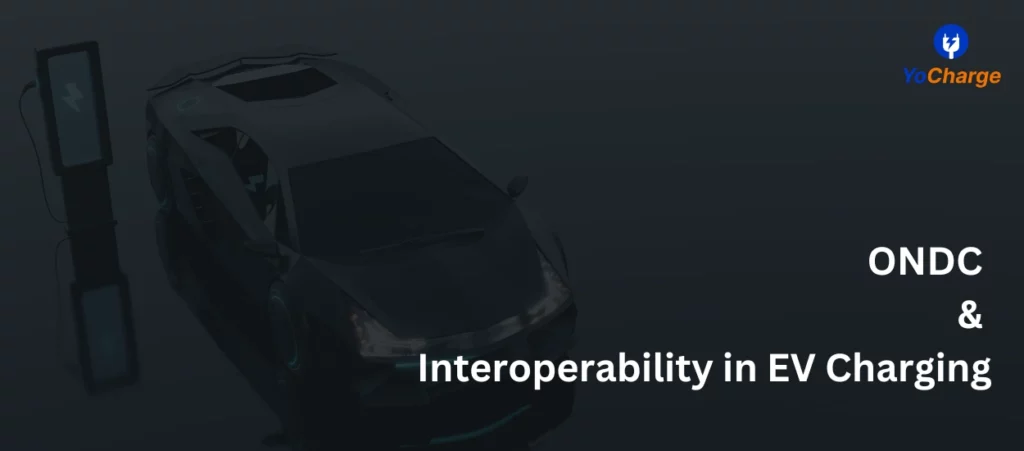
Digital commerce is transforming the world of business, and there’s a need to make it more equal and inclusive for all level of businesses. Further, despite the meteoric growth in recent years, India’s e-commerce sector still has much untapped potential with e-retail penetration at 5-7%. In this article, we brief about ONDC, what changes ONDC aspires to bring in digital commerce & how ONDC can promote interoperability in EV Charging.
State of Digital Commerce in India
India’s digital commerce industry has evolved and picked up significant momentum during the past few years which was further accelerated by compulsions on account of COVID-19. The ongoing digital transformation in fuelled by access to internet connectivity at affordable cost, increase in smartphone penetration and increased investments in the start-up ecosystem, together with government innovations like Unified Payment Interface (UPI) etc. India now has the third-largest online shopper base globally, with 14 crore e-retail shoppers in 2020, only behind China and the US.
The problems with India’s digital commerce infrastructure
On consumer side, still only about ~20% of the internet users in India are shop online. The Gross Merchandising Value (GMV) for the digital commerce retail market in India was ₹2.85 Lakh Crores (US$ 38 billion) in 2020, which is only 4.3% of the total retail GMV in India and well below the e-retail penetration in countries like China (25%), South Korea (26%), and UK (23%). By 2026, digital commerce in the retail sector in India is expected to grow to ₹15 Lakh Crores (US$ 200 billion). However, a much larger problem lies on the supply or seller side.
As of September 2020, India is estimated to have 4.25 crore Micro, Small and Medium Enterprises (MSMEs) that are not part of this digital revolution. These MSME’s have the potential but lack the skill & capacity to build digital channels. Consequently, a number of marketplace platforms have come up as a solution to address this problem.
These digital marketplaces come as a one-stop solution connecting the seller to the buyer, along with providing integrated services like warehousing, logistics, payment, etc. However, the extent of investment required to establish such integrated solutions limits the number of players and so the sellers tend to end-up being at mercy of these platforms.
Even if the number of such digital marketplaces increases, the sellers are required by the platforms to maintain separate infrastructure and processes, adding to their cost which also limits participation capability. Consequently, there is need to look at digital commerce architecture & infuse changes at fundamental level. There is a priority need to make digital commerce in goods and services available equitably to all levels of businesses.
What is ONDC ?
ONDC is Open Network for Digital Commerce
At DNA level, ONDC symbolises a paradigm shift from an operator-driven monolithic platform-centric model, to a facilitator-driven, interoperable decentralized network. ONDC is premised upon the core concepts of decentralization, openness, and greater user utility. By definition, ONDC is a set of specifications designed to enable an open interchange and connections between shoppers, technology platforms, and retailers.
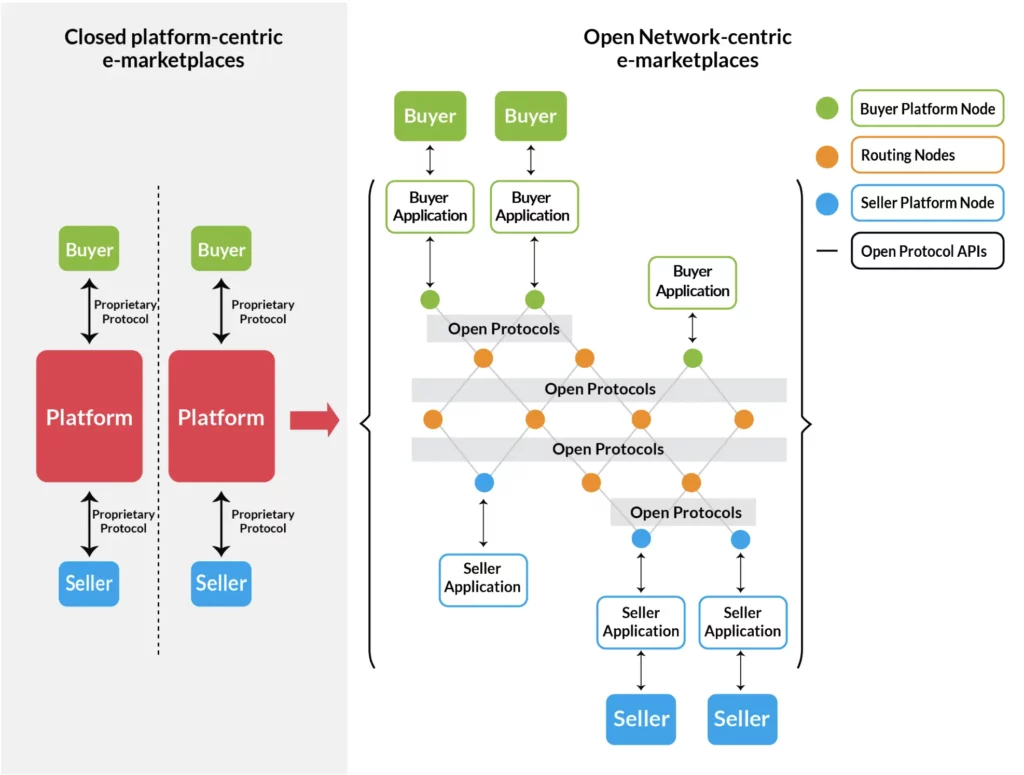
The key premise of ONDC is based on two concepts: Unbundling and interoperability. ONDC does this by breaking a typical commerce transaction into parts (unbundling) and creating protocols so that everyone on the network can seamlessly work on these unbundled parts (interoperability).
Concept of Open Network
As the Simple Mail Transfer Protocol (SMTP) is for emails, Hypertext Transfer Protocol (HTTP) is for the World Wide Web, UPI for the payment systems, the Open Network idea has been conceived to transform digital commerce in India.
Open Network goes beyond the current platform centric model where the buyer and seller must be part of the same platform/ application to enable transactions between them.
Instead, in an open network so long as the platforms/applications are interoperable, buyers and sellers can transact no matter what platform/application they use to be digitally visible/available enabling the flow of value as depicted in next figure.
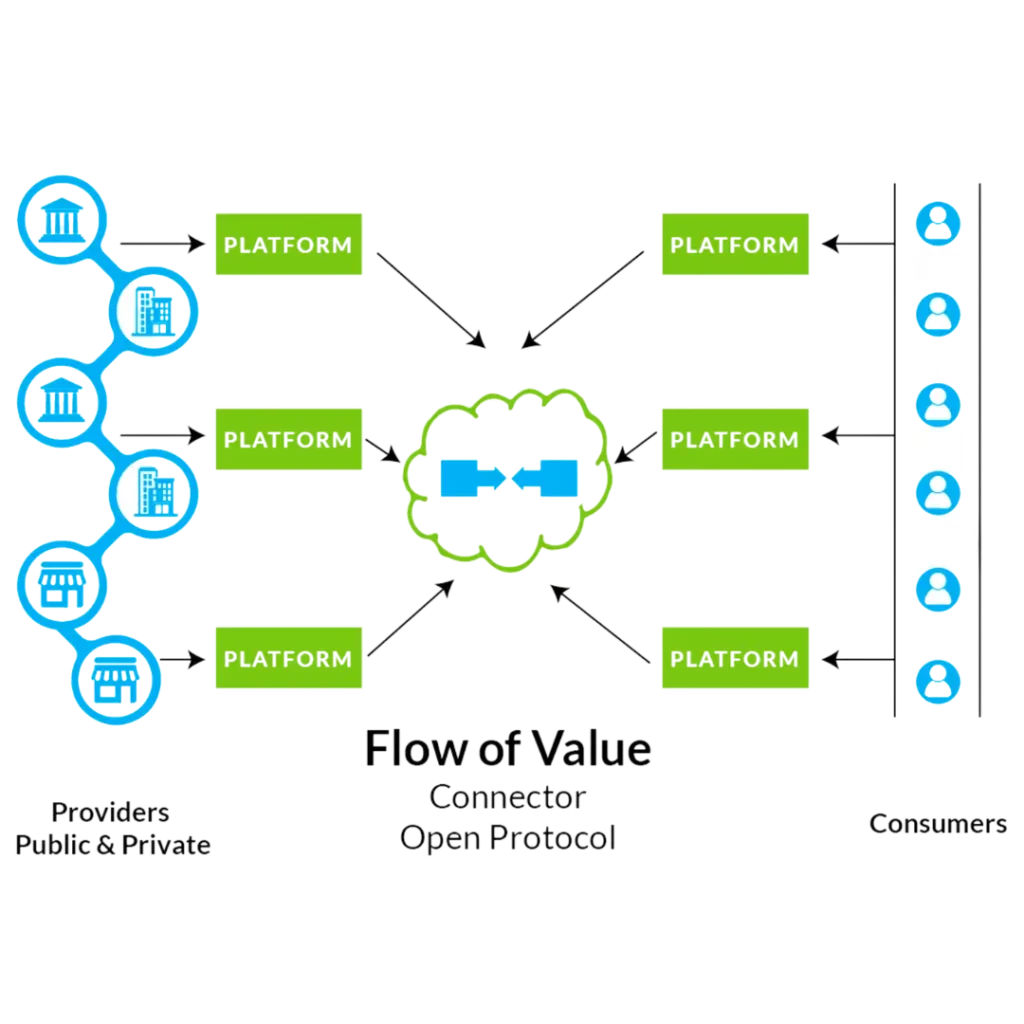
What is Beckn Protocol ?
Beckn Protocol is a common set of rules of communication mutually agreed upon by several platforms to allow their users to perform discovery, ordering, fulfilment and post-fulfilment activities between each other in a standard way. Similar to HTTP for websites or SMTP for emails, beckn Protocol creates a common language for interoperability among different digital platforms and networks for facilitating economic transactions.
It is a sector-agnostic protocol, meaning, any industry-specific taxonomy or knowledge model can be represented using the data model of beckn protocol.
Beckn Protocol & EV Charging
The Unified Energy Interface (UEI) Protocol is an adaptation of beckn protocol for transactional use cases in the energy sector. UEI simplifies energy transactions and enables an open network for energy systems. It acts as a a decentralized network of platforms that perform interoperable commercial transactions that result in the transfer of energy from a energy provider to an energy consumer.
Imagine you are out on a bike ride with your family and need to stop for a cool drink. But there are so many shops, you are not sure which one has what you want! Would not it be cool if there was a special signal that told you exactly which shop sells cold drinks?
That’s kind of what the Beckn Protocol [ref] does for electric vehicles (EVs) and charging stations! It is like a special language that lets EVs and charging stations talk to each other. Here is how it makes finding a charge a breeze:
Finding Available Chargers
- Just like looking for a cold drink shop, you can use your phone or a special app to find nearby charging stations.
- The Beckn Protocol helps the app talk to the stations and see which ones have empty plugs available.
- This way, you won’t waste time driving around looking for an open spot!
Knowing Before You Go
- Not all charging stations are created equal! Some are faster than others, and some cost more to use.
- The Beckn Protocol lets the app show you all this information before you even leave home.
- You can choose the station that is closest, fastest, or fits your budget!
Easy Payments
- No more scrambling for cash or credit cards!
- The Beckn Protocol helps the app connect to the station’s payment system.
- You can pay for your charge right from your phone, just like buying a game online!
Benefits For Everyone
- Beckn Protocol is not just good for EV drivers.
- Charging station owners can also use it to advertise their services and attract more customers.
- This can lead to more charging stations being built, making it even easier for everyone to go electric!
The Beckn Protocol paves the way for a cleaner future with more electric cars on the road by making EV charging simpler and more convenient.
The problem of Interoperability in EV Charging in India
The evolution of EV infrastructure in India has been marked by the growth of numerous independent charging networks & charge point operators, each backed by its proprietary software platform & mobile apps. This means that each CPO has their own apps to locate charging points, book slots, and handle payments. For an EV user, this translates to downloading and managing multiple apps based on their travel routes or the availability of charging points.
The User’s Quandary
Imagine driving across multiple cities and having to switch between various CPO apps to locate a compatible charging station or even within a city, cross-referencing between two or three apps to find the nearest available spot. Not only does this make the EV charging experience tedious but also reduces the spontaneity and freedom associated with driving.
Implications for EV Adoption
For potential EV buyers, this can be a deterrent. The allure of EVs, beyond their environmental benefits, lies in their convenience. If every charging experience becomes an exercise in app navigation and management, the charm diminishes. It may even lead to range anxiety, where users are constantly worried about finding the next compatible charging station, lest their vehicle runs out of charge.
How ONDC promotes EV Charging Interoperability
ONDC is both open source and open access. The Unified Energy Interface (UEI), built on the Beckn Protocol for Energy, which aggregates various platforms, including energy storage, battery banks, home batteries, EV vehicles, idle commercial EVs, rooftop solar panels, CPOs and more.
Nobody needs any clearances or permissions to create a fully functional application and also all relevant information on creating such working application is publicly applicable. Now, if Charging Point Operators are enabled on ONDC infrastructure, this means that:
- Firstly, anyone can create applications to help aggregate, discover, operate the charging stations.
- Secondly, more importantly, the EV user can be on his/her favourite app say PayTM etc and can use the charging stations from within the app. There is no need for the EV user to keep on downloading third-party apps, recharge each wallet & keep minimum balances on each of them.
- Thirdly, the Charging Station Operators are able to receive charging from multiple apps including apps with existing user base. This provides them instant discoverability, increases their occupancy rate & surges revenue.
Early innovators, such as cloud energy storage platforms for grid operators and EV charging platforms, are adopting the UEI to enhance their services. These innovators aim to aggregate significant storage capacity and increase the utilization rate for thousands of charging stations, expanding accessibility for EV drivers.
Difference between ONDC (Beckn Protocol) & OCPI
EV roaming simplifies the charging process by allowing EV users to charge on different charging networks without the need to create multiple subscriptions. The EV Roaming Protocols facilitate the communication between your native charging service provider and different charging station operators. The Open Charge Point Interface protocol (OCPI) is one such protocol facilitation interoperability.
So while, OCPI is limited to promoting interoperability in ev charging. ONDC (Beckn protocol) is sector agnostic protocol for digital commerce, meaning any industry-specific taxonomy or knowledge model can be represented using the data model of beckn protocol. This will allow platform to serve multiple utilities (products or services) using the same protocol and the same app.
Read Ahead
Way ahead
The solution lies in creating a unified & decentralised solution where all CPOs can broadcast their stations, and users can effortlessly locate, book, and pay for charging slots without any limitation for mobile applications. By fostering collaborations between different CPOs and encouraging the adoption of ONDC based protocols, it’s possible to bring all charging stations under one digital umbrella.
The Beckn Protocol and the Unified Energy Interface (UEI) are crucial in India’s transition to Electric Mobility, as they enable a unified energy ecosystem, simplifying energy transactions and enabling transactions between digital energy systems.
The UEI solves problems related to discovery, ordering, fulfillment, and post-fulfillment, and supports open networks for energy, virtual energy storage and battery monetization networks, and EV charging networks. Early innovators, such as cloud energy storage platforms and EV charging software platforms, are already adopting the UEI to enhance their services, aggregating significant storage capacity and increasing the utilization rate for thousands of charging stations.
